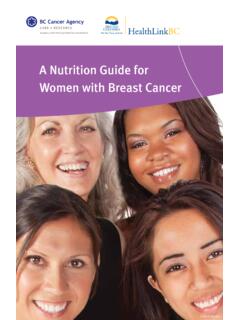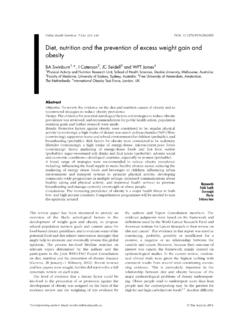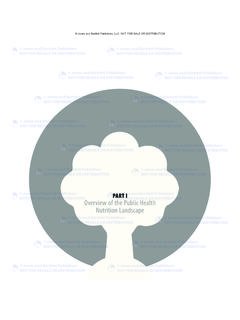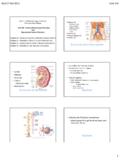Transcription of Mercy’s 2013 Cancer Program Annual Report
1 Mercy s 2013 Cancer Program Annual ReportMercy Hospital & Medical Center is accredited by the Commission on Cancer as an Academic Comprehensive CancerProgram. This study directed by the Mercy s Cancer Committee relates to Standard : Assessment of Evaluation andTreatment Planning. Uterine Cancer patients initially diagnosed at Mercy are compared to their national , screening, demographics, stage at presentation, navigation, initial course of treatment, survival, nutrition andsurvivorship will be analyzed.! Mercy Five Most Common Female Sites Mercy 2012 vs 2013 ACS Estimates 53%10%8%4%3%2%9%6%4%3%14%29%0%10%20%30%4 0%50%60%BreastColon & RectumLungUterus LymphomaKidney!Uterus Ra ce /Ethnicity Mercy 2007 to 2012 vs NCDB 2011 30%55%9%6%79%10%6%5%0%10%20%30%40%50%60% 70%80%90%WhiteBlackHispanicAPIM ercy 2007 to 2012 NCDB 2011 Incidence The American Cancer Society estimates that 49,5601new uterine cancers will be diagnosed in the in2013, accounting for 3% of total estimated new cases.
2 Uterine Cancer is the most common gynecologic malignancydiagnosed in the United States. The incidence of uterine Cancer has been rising and may be partially attributable totrends in both the aging of the population and increasing obesity. Uterine cancers accounted for 3% Mercy s analyticcaseload in 2012 but preliminary registry data review exhibits an increase in 2013 Cancer Facts & Figures 2013 pg 4 Demographics As seen above, over 50% of women diagnosed with uterine Cancer at Mercy Hospital are AfricanAmerican. This is more than 5 times the national statistics where Black women are through to represent between 7-10%of all new cases. Uterine Cancer is also an area of significant health disparity, possibly due to factors such as delays in care,differences in surgery utilization, and more aggressive tumor types (4-5).
3 This disparity persists even when controlled forstage and treatments. African American women are more likely to die from their disease; they represent 7% of all newcases, but 14% of deaths. According to national data, the 5-year survival rate for African American women is 70%compared to 90+% for white women. African American women with advanced stage disease have a 31% 5-year survivalcompared to 58% for white women (6). These statistics are compounded by higher rates of obesity, diabetes and cardiacdisease in African American women. The demographic profile of the Mercy hospital cohort also likely affects differencein survival which will be reviewed later.!Uterus Histology Mercy 2007 to 2012 vs NCBD 201184%10%73%2%0%20%40%60%80%100%Adenoca rcinomaSarcomaMercy 2007 to 2012 NCBD 2011 Stage at Diagnosis Nationally, the vast majority of patients diagnosed with uterine Cancer with Stage I disease limited tothe uterus while a smaller proportion will present with advanced stages: Stage III due to involvement of vagina, adnexaor regional lymph nodes or Stage IV involvement of upper abdomen, liver, lung or other distant sites.
4 As seen in thischart, the women diagnosed at Mercy hospital are a high risk cohort in comparison as approximately 40% will presentwith advanced stage at initial diagnosis. Education of patients, primary care providers, emergency room providers about the symptoms of uterine Cancer such aspostmenopausal vaginal bleeding to trigger rapid referral for gynecologic or gynecologic oncology evaluation byendometrial biopsy will be emphasized to try to improve this disparity in our high risk The distribution of histology types seen at Mercy Hospital compared to the NCDB demonstrates that there isa higher percentage of sarcomas which are a more aggressive type of uterine cancers associated with higher stage atpresentation, higher recurrence risk and worse overall survival in compared to most of the adenocarcinoma cancers.
5 Thissubtype is also found in increased frequency in African American women and may contribute to the racial disparity seenin overall survival. !Uterus Stage at diagnosis Mercy 2007 to 2012 vs NCDB 201152%9%19%20%70%12%7%5%0%10%20%30%40%5 0%60%70%80%Stage IStage IIStage IIIS tage IV Mercy 2007 to 2012 NCDB 2011Co-morbid Conditions Most women with endometrial Cancer are likely to be diagnosed early and cured of their disease(1). Despite a positive Cancer outcome, the major risk factors for this Cancer , which include obesity and diabetes, persistlong after the Cancer diagnosis, placing these women at high risk for future morbidity and mortality (2). Studies estimatethat 60-80% percent of women are overweight or obese at the time of diagnosis. As seen above, the uterine cancerpatients at Mercy have high rates of obesity and associated comorbid conditions such as cardiovascular disease.
6 Suchcomorbid conditions are associated with poor quality of life, survival and can effect treatment options including surgery,chemotherapy and radiation.!Uterus Cancer Analytic Cases 2007 to 2012 BMI / Cardiovascular Disease 45%84%58%16%0%20%40%60%80%100%BMI < 25 withcardiovascular diseaseBMI < 25 BMI > 25 withcardiovascular diseaseBMI > 25 Percentage of patientsTreatment 86% of Stage I patients, 83% of Stage II patients, 75% of Stage III and 92% of Stage IV patients receivedappropriate surgical intervention by our team of surgeons in the Gynecologic Oncology Service which is consistent withnational standard of care. Surgery generally includes total hysterectomy, bilateral salpingo-oophorectomy and pelvicand/or para-aortic lymphadenectomy when clinically indicated. Stage IV patients may undergo more extensive debulkingprocedures with the goal for maximal cytoreduction to optimize survival.
7 At Mercy Hospital, as many of the patientshave high risk histology or higher stage disease, many will require adjuvant treatment with either chemotherapy and/orradiation. Their care is closely coordinated in a multidisciplinary fashion among the physicians in Gynecologic Oncology,Radiation Oncology and Medical Oncology. Challenging clinical cases can be presented at the hospital wide MercyHospital Tumor Board. A small but important proportion of patients had no treatment at Mercy hospital due to co-morbid conditions, patient refusal, patient s electing for hospice care or loss of follow-up.!Mercy Uterus 2007 to 2012 Treatment by Stage 69%8%17%17%83%67%50%42%17%3%8%8%11%01020 30405060708090 Stage IStage IIStage IIIS tage IVpercent of patientsSurgerySurgery & Adjuvant Chem o / RadiationNo treatm ent Survival Endometrial Cancer is also an area of significant health disparity, possibly due to factors such as delays in care,differences in surgery utilization, and more aggressive tumor types (4-5).
8 African American women are more likely to diefrom their disease; they represent 7% of all new cases, but 14% of deaths. According to national data, the 5-year survivalrate for African American women is 70% compared to 90+% for white women. African American women with advancedstage disease have a 31% 5-year survival compared to 58% for white women (6). These statistics are compounded byhigher rates of obesity, diabetes and cardiac disease in African American women. The survival of women with uterine Cancer at Mercy is compared here to the NCDB data. As can be seen, after 2 years,the survival of patients treated at Mercy is approximately 10% lower than the national statistics. The discrepancy insurvival statistics is likely to be explained by Mercy s higher risk cohort of patients who as seen in prior graphs are morelikely to be African American, to have more advanced stage at presentation, and higher risk histology.
9 In addition,multiple comorbid conditions can adversely affect performance status and greatly limit treatment options in both theadjuvant and recurrent disease setting. Cancer Navigation The journey from the diagnosis of Cancer through survivorship is challenging for any Navigators guide patients through the continuum of Cancer care. When utilized to their full potential CancerNavigators function as a focal point for patients and their treating physicians. Beyond assisting patients in obtainingtimely diagnostic imaging, consults and treatments, navigators can facilitate communication between treating physiciansand between treating physicians and support services. The Patient Clinical Navigator in Gynecologic Oncology, CarolNewsom RN (312-567-5567) helps patient negotiate the challenges of multi-modal therapy that many of these patientsare facing.
10 !Uterus Observed Survival Cases Diagnosed in 2003- 2006 M ercy vs NCDB 95%85%71%69%69%93%87%83%80%78%0204060801 00120012345 Years from Diagnosis Cumulative Survival Rate Mercy 2003 to 2006 NCDB 2003 to 2006!Mercy Observed Survival !Cases diagnosed 2003 to 2006 !Black vs All Other!52%!56%!56%!78%!96%!79%!79%!85%!85 %!95%!0!20!40!60!80!100!0!1!2!3!4!5!Blac k!All other!Nutrition Obesity and diabetes are well established independent risk factors for the development of endometrial cancerwhich is the most commonly seen subtype of uterine Cancer . A recent review of over 33,000 endometrial Cancer survivorsdemonstrated that cardiovascular disease was the leading cause of death in women with low grade early stage disease. Forboth high and low risk endometrial Cancer patients, risk of death due to cardiovascular events was higher than risk ofdeath from the Cancer after 5 years (3).






